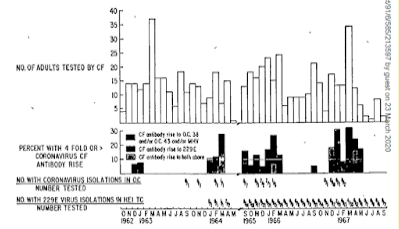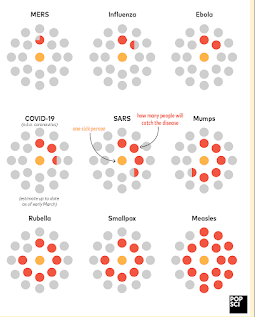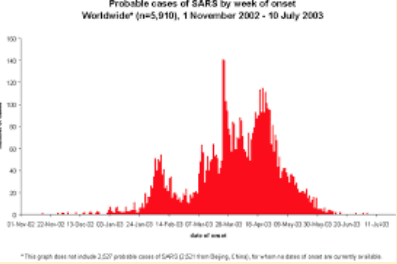
Coronaviruses are a large family of viruses that cause disease in animals and humans. They were discovered as a cause of the common cold more than 50 years ago. In some studies, up to 30% of colds in children and adults were caused by these viruses.
 Coronavirus colds, in temperate climes, have a clear seasonality with a preference for the winter months (Figure below, in bar chart). They occur more sporadically in tropical climates, but there they seem to prefer spring and fall.
Coronavirus colds, in temperate climes, have a clear seasonality with a preference for the winter months (Figure below, in bar chart). They occur more sporadically in tropical climates, but there they seem to prefer spring and fall.
SARS or severe acute respiratory syndrome was another pandemic that started in China. Like the current covid-19 pandemic, it originated in bats. The intermediate host for SARS was thought to be civet cats sold in China’s ubiquitous wild animal markets. As with today’s covid-19 outbreak, the epidemic was initially hidden by Chinese officials. SARS was a more transmissible virus, where each infected person transmitted the virus to 3.5 other people compared to covid’s 2.5 others.
 And SARS was more deadly with a mortality rate approaching 10%. Covid-19 looks like it will end up with a mortality rate of well under 1% globally when all the testing is finally done. This figure will depend on many factors including the capacity and quality of the healthcare systems where the epidemic is occurring. SARS ultimately infected 8000 people globally with the vast majority of cases in Asia and caused over 700 deaths. But the most hopeful observation about SARS is its epidemic curve (see bar chart directly below). The pandemic started in November of 2002 but was over by July of 2003. Why? It’s hard to believe that suddenly our ability to carry out case-finding and isolation of contacts had improved to the point where we could stop the virus in its tracks. I’m voting for seasonality. Why didn’t it come back the next year? Certainly not because the world was immune. I don’t know – perhaps some of you have the answer.
And SARS was more deadly with a mortality rate approaching 10%. Covid-19 looks like it will end up with a mortality rate of well under 1% globally when all the testing is finally done. This figure will depend on many factors including the capacity and quality of the healthcare systems where the epidemic is occurring. SARS ultimately infected 8000 people globally with the vast majority of cases in Asia and caused over 700 deaths. But the most hopeful observation about SARS is its epidemic curve (see bar chart directly below). The pandemic started in November of 2002 but was over by July of 2003. Why? It’s hard to believe that suddenly our ability to carry out case-finding and isolation of contacts had improved to the point where we could stop the virus in its tracks. I’m voting for seasonality. Why didn’t it come back the next year? Certainly not because the world was immune. I don’t know – perhaps some of you have the answer.
 Another deadly coronavirus to cause epidemic disease was MERS – for Middle East Respiratory Syndrome. Again, the origin of the virus was bats but the intermediate host appears to have been camels. The disease appeared in epidemic form in Saudi Arabia in 2012 and still causes sporadic small clusters of disease mainly in that area. Overall, there have been 2442 confirmed cases globally and 843 deaths according to the WHO. MERS is also seasonal with a peak in Saudi Arabia during the winter months and spring and fall in outside the Middle East (mainly Asia).
Another deadly coronavirus to cause epidemic disease was MERS – for Middle East Respiratory Syndrome. Again, the origin of the virus was bats but the intermediate host appears to have been camels. The disease appeared in epidemic form in Saudi Arabia in 2012 and still causes sporadic small clusters of disease mainly in that area. Overall, there have been 2442 confirmed cases globally and 843 deaths according to the WHO. MERS is also seasonal with a peak in Saudi Arabia during the winter months and spring and fall in outside the Middle East (mainly Asia). 



